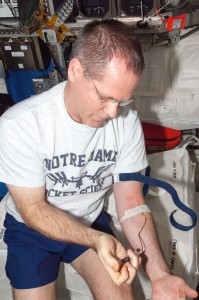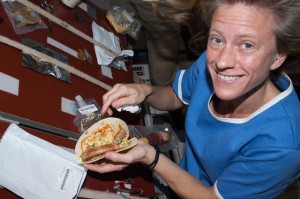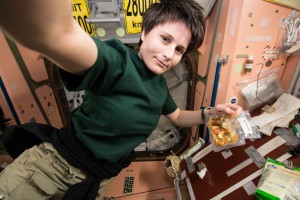In today’s A Lab Aloft NASA research scientist Sara Zwart, Ph.D., shares the compelling results of studying nutrition with the crew of the International Space Station.
What you eat can affect your performance and health, in both the short term, and over the course of your life. Eating a balanced diet is important to be sure you get all required nutrients to avoid deficiencies, but at the same time to avoid getting too much. The reason is that nutritional status in general, and the status of particular individual nutrients, often follows a bell-shaped curve. The top of the bell, representing the most favorable amount of a nutrient, is between two unfavorable amounts, not enough and too much. Iron is one of those nutrients.

Most people are familiar with iron deficiency, and now there is a growing awareness of health problems associated with having too much iron in the body. It can be difficult for the body to get too much iron, as it absorbs only a small fraction of the amount consumed in the diet. Once iron is absorbed, however, the body doesn’t have a routine way to get rid of any excess. One way to reduce the amount of iron in the body is to donate blood. In population studies, people who donated blood more often had a lower risk of cardiovascular disease than those who did not donate blood or donated it less often. This is just one example of the relationship between iron excess and disease.
Iron status is one of the areas covered by our lab’s ongoing Biochemical Profile study, for which blood samples are collected before, during, and after crew members’ flights to and from the International Space Station. These samples allow us to monitor changes in nutrition and other physiological systems during missions aboard the orbiting lab. As a side note—the amount of blood we collect at each blood draw is relatively small, less than 10 percent of a typical blood donation.

When the body has an excess of iron, it uses specific molecules to transport and store the iron. We see an increase in body iron stores in astronauts early during spaceflight, and iron stores return to preflight levels in most crew members by the end of the flight. There are several potential causes for this increase astronauts experience when they begin their time in orbit.
First – the food system contains more iron than desired, on average about three times the recommended dietary allowance. Many food items on the space station are commercially available, and common items found on grocery store shelves (like bread and cereal) are fortified with iron.
Second – iron stores increase in response to a decrease in red blood cell mass. That decrease is a normal physiological change of spaceflight. We believe that because it is easier for the heart to pump blood to the body in microgravity, less blood is required, and the body reduces the volume of blood in the circulation. This reduction happens in the first two weeks of spaceflight, and the iron from the blood cells is put into storage—because, as noted earlier, the body doesn’t have a way to get rid of it.

In looking closely at the pattern of changes in iron status, we found that the increase in iron stores during spaceflight was related to both oxidative damage and bone loss. Think of oxidative stress in the body as similar to rust on a car. There are molecules in the body that react when exposed to certain factors such as oxygen, radiation, and even excess iron. The crew members who had the biggest increase in iron stores had the most bone loss. Those who had taken the longest time for iron stores to return toward preflight levels also had more bone loss. The next step will be to study the mechanism for how the oxidative damage is associated with bone loss, which is currently being studied on Earth as well.
Among the unique aspects of spaceflight research are the generally very healthy condition of astronauts, and the nature of the changes observes in the spaceflight environment. We observed these changes in a matter of months, whereas similar research on Earth would take years. The findings emphasize that excess iron can have negative consequences on many systems in the body in space or on Earth.

Further spaceflight research is needed to better understand how iron metabolism changes in astronauts on long-duration missions, and how these changes are related to other health concerns of space travel, including immune dysfunction and radiation-induced cancer risk. On exploration-class missions to other planets or celestial bodies, changes in iron metabolism on either side of the bell-shaped curve could cause or contribute to significant health issues. Our Biochemical Profile study, for which we are tracking nutrition status along with markers of bone metabolism and general chemistry, will allow us to continue to monitor iron status of astronauts and determine what other body systems are affected.

On either side of the iron bell curve, humans face health challenges and we hope to find data to help advance answers for the medical community. In the broader context, research on the far-reaching effects of increased iron stores suggests that studies aboard the space station have implications well beyond NASA for the general medical and scientific communities. Better recommendations for optimizing iron status for people on Earth may come in the future, thanks in part to the answers discovered for space explorers, but that found their way back home.

Sara R. Zwart is a research scientist with NASA’s Nutritional Biochemistry Laboratory at the Johnson Space Center in Houston. She obtained her doctorate in Nutritional Sciences from the University of Florida in 2003, and B.S. in Biology from The University of Notre Dame. She is a co-author on a recent book, Human Adaptation to Spaceflight: The Role of Nutrition.
